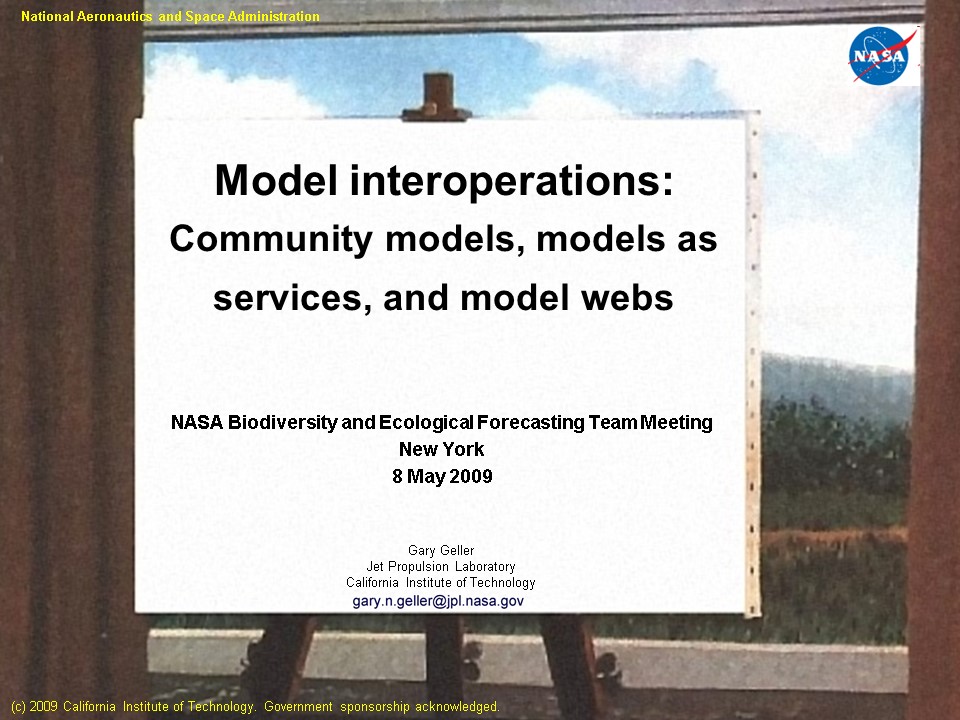Model interoperations: Community models, models as services, and model webs - PowerPoint PPT Presentation
Title:
Model interoperations: Community models, models as services, and model webs
Description:
National Aeronautics and Space Administration Model interoperations: Community models, models as services, and model webs NASA Biodiversity and Ecological Forecasting ... – PowerPoint PPT presentation
Number of Views:92
Avg rating:3.0/5.0
Title: Model interoperations: Community models, models as services, and model webs
1
Model interoperationsCommunity models, models
as services, and model webs
National Aeronautics and Space Administration
NASA Biodiversity and Ecological Forecasting Team
Meeting New York 8 May 2009
(c) 2009 California Institute of Technology.
Government sponsorship acknowledged.
2
GEO Biodiversity Observation Network
- Global network
- Of interoperating biodiversity observation
systems - Collect, manage, analyze, share data on status of
the worlds biodiversity
Scholes et al., Science 321 22 August 2008,
Toward a Global Biodiversity Observing System
3
Focus is monitoring
- Ecosystems
- Species
- Genes
- Ecosystem services
4
Primary tasks
- Integrate existing observation systems
- Coordinate sampling efforts
- Fill in sampling gaps
- Integrate and add analytical/visualization tools
- Combine remote sensing and in situ data
5
Self assessment
- Concept is all-inclusive
- Very ambitious
- Organic and opportunistic
- Long-term
- Community-driven and coordinated
6
Status
- Concepts published
- Implementation approach articulated
- Detailed implementation planning underway
- Ecosystems
- Species
- Genes
- Terrestrial
- Marine
- Aquatic
Sound interesting?
7
Model interoperationsCommunity models, models
as services, and model webs
National Aeronautics and Space Administration
NASA Biodiversity and Ecological Forecasting Team
Meeting New York 8 May 2009
(c) 2009 California Institute of Technology.
Government sponsorship acknowledged.
8
Overview
- Ecological questions
- Greater model integration
- Community modeling
- Models as services
- Model Web
9
General questions
- What will change?
- What will be the consequences of those changes?
10
Specific examples
What areas in Burma should be targeted to protect
the critically endangered Gurney's Pitta?
How will water availability be affected, by
annual and seasonal measures? Do we need to
build more reservoirs?
- USFWS Should pika be listed as threatened /
endangered? - BCC What are the ecological and social
implications of complete build-out in Boulder
according to the existing regional zoning plan? - USNPS Where should we burn? Will we violate AQ
standards in the Central Valley? - NGOs What areas in Asia should be the focus of
conservation efforts to save the tiger and its
habitat? - USGEO What are the consequences of alternative
land management practices on biological diversity
in the context of climate change? - NEON How do changes in the availability and
distribution of the nations water affect
ecological systems? - DS How will the boreal forest shift as
temperature and precipitation change at high
latitudes? What will be the impacts on animal
migration patterns and invasive species?
How will social and economic factors change
forest cover of Peruvian Amazon by 2020?
How will climate change and socioeconomic factors
affect infection rates of vector-borne diseases?
How will snowfall be affected?
How will flood risk be affected?
How much will sea level rise?
How will fire risk and intensity be affected?
What effect will various management options have
on the critical values of my park?
What do we need to do to restore the landscape of
an overgrazed African ecosystem?
How will increased development and forest
fragmentation effect the abundance of a
forest-dependent bird species?
How will urban temperatures in SF be changed?
11
- How many of these questions can be easily
answered, or explored, now? - Can a resource manager easily get information on
these topics?
12
Limiting factors
- Science and observations
- Isolated modelslimited interoperability
- Limited sharing
- Limited access
Cultural barriers are much more limiting than
technical ones
13
The need for community modeling
- More sharing / improved access
- Less reinvention
- Facilitates new science
- Enhances integrated management and decision
support
Adapted from J Famiglietti et al 2008. CUAHSIs
efforts towards a Community Hydrologic Modeling
Platform (CHyMP) in the USA
14
- Should we encourage more community ecological
models?
15
Models as services
- Service provision of a product upon request
- Service Oriented Architecture
Service request
Service Provider
Consumer
Information
16
Models as (web) services
- Data provider Standard method for data sharing
- Well-known technology
- Data consumer Improved access
- To people
- To other models
Not for all models
17
Models as services
18
Models as services
Model web
19
Benefits
- More sharing / improved access
- Less reinvention
- Facilitates new science
- Enhances integrated management and decision
support - Greater modeler interaction
- More users ? more feedback ? faster improvement
Web 2.0
20
Web 2.0
- Web 2.0
- Collaboration
- Communities
- Interactivity, feedback
- Collective intelligence
- Web 3.0?
- Semantic Web ? Model Web
Community models
21
Summary
- Need more model interoperability
- Community modeling
- Models as services
- Room for Web 2.0
- Longer term model web?
- Think big, start small, start soon
http//www.wordle.net/
Created with Wordle http//www.wordle.net/.































